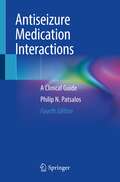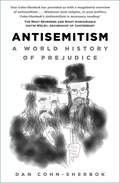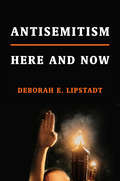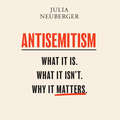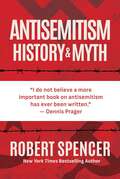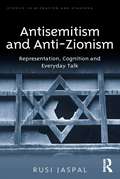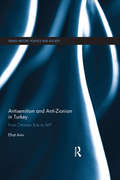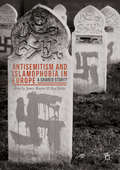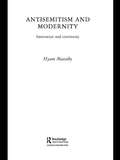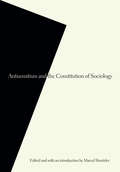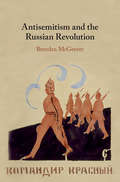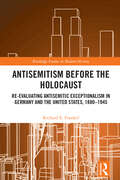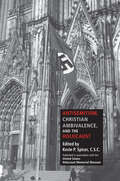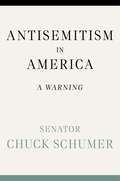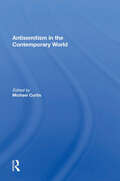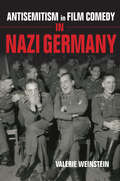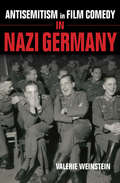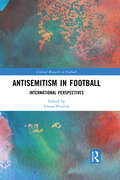- Table View
- List View
Antiseizure Medication Interactions: A Clinical Guide
by Philip N. PatsalosThis significantly revised fourth edition provides a practically orientated guide to interactions associated with antiseizure medications. It describes pharmacokinetic and pharmacodynamic antiseizure medication (ASM) interactions, including details of the magnitude and mechanism of interactions, and also of drug combinations that are not associated with interactions and therefore can be co-prescribed without undue concern. Presented in alphabetical order and by drug class, drug interactions that occur between ASMs and also between ASMs and non- ASMs are described in three sections: Drug interactions between ASMs; Drug interactions between ASMs and non- ASM Drugs: Interactions affecting ASMs; Drug interactions between ASMs and non ASM Drugs: Interactions affected by ASMs. The latest data on all drug interactions is presented. New agents discussed include cannabidiol, cenobamate, everolimus and fenfluramine,. Antiseizure Medication Interactions: A Clinical Guide, 4th Edition concisely presents the most recent developments and data available on the topic. Therefore, enabling physicians and allied health professionals to make more rational choices when ASM polytherapy regimens are required. It will be of interest to medical professionals in disciplines including neurology, psychiatry and pediatrics.
Antisemitic Myths: A Historical and Contemporary Anthology
by Marvin Perry Frederick M. SchweitzerThis anthology presents 90 documents that focus on the nature, evolution and meaning of the principle myths that have made anti-Semitism such a lethal force in history: Jews as deicides, ritual murderers, agents of Satan, international conspirators, and conniving, unscrupulous Shylocks.
Antisemitism: Part One of The Origins of Totalitarianism (The Origins of Totalitarianism #1)
by Hannah ArendtIn the first volume of her landmark philosophical work, The Origins of Totalitarianism, the political theorist traces the rise of antisemitism in Europe. Since it was first published in 1951, The Origins of Totalitarianism has been recognized as the definitive philosophical account of the totalitarian mindset. A probing analysis of Nazism, Stalinism, and the &“banality of evil&”, it remains one of the most referenced works in studies and discussions of totalitarian movements around the world.In this first volume, Antisemitism, Dr. Hannah Arendt traces the rise of antisemitism to Central and Western European Jewish history during the 19th century. With the appearance of the first political activity by antisemitic parties in the 1870s and 1880s, Arendt states, the machinery that led to the horrors of the Holocaust was set in motion. The Dreyfus Affair, in Arendt&’s view, was &“a kind of dress rehearsal&”—the first modern use of antisemitism as an instrument of public policy and of hysteria as a political weapon.&“The most original and profound—therefore the most valuable—political theorist of our times.&”—Dwight MacDonald, The New Leader
Antisemitism: A Very Short Introduction
by Steven BellerThis Very Short Introduction examines and untangles the various strands of antisemitism seen throughout history, from medieval religious conflict to 'new' antisemitism in the 21st century. Steven Beller reveals how the phenomenon grew as a political and ideological movement in the 19th century, how it reached it its dark apogee in the worst genocide in modern history - the Holocaust - and how antisemitism still persists around the world today.
Antisemitism: A World History of Prejudice
by Dan Cohn-Sherbok‘Dan Cohn-Sherbok has provided us with a magisterial overview of antisemitism . . . Whatever your religion, or your politics, Cohn-Sherbok’s Antisemitism is necessary reading.’ The Most Reverend and Right Honourable Justin Welby, Archbishop of Canterbury‘A very readable overview on four millennia of Judaeophobia . . . a timely book and shows the flame of antisemitism continues to burn bright.’ Rabbi Professor Walter HomolkaAntisemitism has featured in the history of Western civilization for over 3,000 years. Dan Cohn-Sherbok traces its origins and its manifestations, from political opposition to racial persecution to religious and philosophical justification for some of history’s most outrageous acts. Against this background of intolerance and persecution, Cohn-Sherbok describes Jewish emancipation from the late eighteenth century and its gradual transformation into the parallel political and nationalistic ideal of Zionism.Antisemitism: A World History of Prejudice offers a clear and readable account of why antisemitism has featured so strongly in world history, and provides extensive discussion of the issues that exist to this day. Unlike most studies of the subject, it does not focus exclusively on Christian antisemitism, but explores the origins of Arab and organized Communist antisemitism and Nazi racism.Brought right up to date with an exploration of how modern-day antisemitism ought to be defined in order to combat it, this revised edition is essential reading not only for history students and theologians, but anyone interested in learning about why the Jews have been hated for so long.
Antisemitism: Here and Now
by Deborah E. LipstadtThe award-winning author of The Eichmann Trial and Denial: Holocaust History on Trial gives us a penetrating and provocative analysis of the hate that will not die, focusing on its current, virulent incarnations on both the political right and left: from white supremacist demonstrators in Charlottesville, Virginia, to mainstream enablers of antisemitism such as Donald Trump and Jeremy Corbyn, to a gay pride march in Chicago that expelled a group of women for carrying a Star of David banner.Over the last decade there has been a noticeable uptick in antisemitic rhetoric and incidents by left-wing groups targeting Jewish students and Jewish organizations on American college campuses. And the reemergence of the white nationalist movement in America, complete with Nazi slogans and imagery, has been reminiscent of the horrific fascist displays of the 1930s. Throughout Europe, Jews have been attacked by terrorists, and some have been murdered.Where is all this hatred coming from? Is there any significant difference between left-wing and right-wing antisemitism? What role has the anti-Zionist movement played? And what can be done to combat the latest manifestations of an ancient hatred? In a series of letters to an imagined college student and imagined colleague, both of whom are perplexed by this resurgence, acclaimed historian Deborah Lipstadt gives us her own superbly reasoned, brilliantly argued, and certain to be controversial responses to these troubling questions.
Antisemitism: What It Is. What It Isn't. Why It Matters
by Julia NeubergerAntisemitism has been on the rise in recent years, with violent attacks, increased verbal insults, and an acceptability in some circles of what would hitherto have been condemned as outrageous antisemitic discourse. Yet despite the dramatic increase in debate and discussion around antisemitism, many of us remain confused. In this urgent and timely book, Rabbi Julia Neuberger uses contemporary examples, along with historical context, to unpack what constitutes antisemitism, building a powerful argument for why it is so crucial that we come to a shared understanding now.
Antisemitism: What It Is. What It Isn't. Why It Matters
by Julia NeubergerThere has been a disturbing rise in antisemitism in Europe over the last fifteen years or so, with violent attacks on Jewish targets, increased verbal antisemitism, and an acceptability in many circles of what would hitherto have been condemned as outrageous antisemitic discourse. More recently, the Labour party have come under fire for engaging in antisemitic abuse. Yet despite the dramatic increase in debate and discussion around antisemitism, there is a general sense of confusion about what should and shouldn't be defined as antisemitism - and particularly around criticism of the State of Israel.In this urgently needed book, Rabbi Julia Neuberger uses contemporary examples, along with historical context, to unpack what constitutes antisemitism, building a powerful argument for why it is so crucial that we come to a shared understanding now, and exploring ways of dealing with it.
Antisemitism: What It Is. What It Isn't. Why It Matters
by Julia NeubergerThere has been a disturbing rise in antisemitism in Europe over the last fifteen years or so, with violent attacks on Jewish targets, increased verbal antisemitism, and an acceptability in many circles of what would hitherto have been condemned as outrageous antisemitic discourse. More recently, the Labour party have come under fire for engaging in antisemitic abuse. Yet despite the dramatic increase in debate and discussion around antisemitism, there is a general sense of confusion about what should and shouldn't be defined as antisemitism - and particularly around criticism of the State of Israel.In this urgently needed book, Rabbi Julia Neuberger uses contemporary examples, along with historical context, to unpack what constitutes antisemitism, building a powerful argument for why it is so crucial that we come to a shared understanding now, and exploring ways of dealing with it.
Antisemitism: History and Myth
by Robert SpencerWhy the ancient evil of antisemitism has returned—and how to counter it. &“Had we listened to Robert Spencer and taken heed twenty years ago or even ten years ago, the impact of the Islamists driven antisemitism would not have caught us by surprise. We would have had in place an institutional effort to counter it. &“Here is another opportunity to pay attention to his important work. Read this book!&” –Ayaan Hirsi AliThe Hamas attack upon Israel on October 7, 2023, was one of the most inhuman jihad attacks ever. The attackers gloried in their savagery and vied to outdo one another in cruelty. Yet despite—or perhaps because of—its brutality, that attack unleashed expressions of hatred for Jews that shocked those who assumed such hate was a thing of the past. Global public opinion turned sharply against Israel. One campus protester carried a sign calling for a &“Final Solution.&” Another published a video saying, &“Be glad—be grateful—that I&’m not just going out and murdering Zionists.&” Synagogues all over the US received bomb threats. Jews in Europe and the US were attacked. October 7 also led to a large-scale reappearance of claims about the Jews&’ secret power and malevolence. Claims that Jews are enemies of all that is good have become mainstream as they have not been since Hitler put a bullet in his brain. The record needs to be set straight for anyone who is willing to see the truth. Historian Robert Spencer does just that. He reveals the sources of today&’s Jew-hatred in pre-Christian paganism, Christianity, Islam, and national and international socialism, and rebuts the most common claims against Jews. The resurgence of antisemitism should worry everyone, Jewish and non-Jewish, who is concerned about the recurrence of one of the darkest chapters in human history. The world today is on the brink of returning to such barbarism. Antisemitism: History and Myth is an attempt to keep that from happening.
Antisemitism and Anti-Zionism: Representation, Cognition and Everyday Talk (Studies in Migration and Diaspora)
by Rusi JaspalAntisemitism and anti-Zionism are complex, delineable, yet inter-related social-psychological phenomena. While antisemitism has been described as an irrational, age-old prejudice, anti-Zionism is often represented as a legitimate response to a ’rogue state’. Drawing upon media and visual sources and rich interview data from Iran, Britain and Israel, Antisemitism and Anti-Zionism: Representation, Cognition and Everyday Talk examines the concepts of antisemitism and anti-Zionism, tracing their evolution and inter-relations, and considering the distinct ways in which they are manifested, and responded to, by Muslim and Jewish communities in Iran, Britain and Israel. Providing insights from social psychology, sociology and history, this interdisciplinary analysis sheds light on the pivotal role of the media, social representations and identity processes in shaping antisemitism and anti-Zionism. As such, this provocative book will be of interest to social scientists working on antisemitism, race and ethnicity, political sociology and political science, media studies and Middle Eastern politics.
Antisemitism and Anti-Zionism in Turkey: From Ottoman Rule to AKP (Israeli History, Politics and Society)
by Efrat AvivThe Jewish community in Turkey today is very diverse with extremely different views as to whether Jews are reluctant or enthusiastic about living in Turkey. Many see themselves primarily as Turks and only then as Jews, while some believe quite the opposite. Some deny there are any expressions of antisemitism in Turkey while others would call it xenophobia and would claim that the other non-Muslim communities in Turkey share the same antagonism. ‘Antisemitism and Anti-Zionism in Turkey’ provides a comprehensive history of the extent of antisemitism in Turkey, from the time of the Ottomans, through the establishing of the Turkish Republic, and up to recent times and the AK Party. It also provides an in-depth analysis of the effect of Israeli military operations on antisemitism, from the Second Lebanon War in 2006 to Operation Protective Edge in 2014. Much emphasis is given to the last decade, as scholars and local Jews assert that antisemitism has increased during this period. An illustrated overview of antisemitism in Turkish media, covering newspapers, books, entertainment, and education, is provided. The book also analyses Turkish society’s attitude towards Jews in contrast with other minorities, and examines how the other minorities see the Jews according to their experience with Turkish society and government. A unique poll, data collected from personal interviews and the use of both Turkish and Israeli research resources, all help to provide a fresh insight into antisemitism in Turkey. This book will therefore be a key resource for students and scholars of antisemitism and anti-zionism studies, Turkish Studies and Middle East Studies.
Antisemitism and Islamophobia in Europe: A Shared Story?
by James Renton Ben GidleyThis is the first book to examine the relationship between European antisemitism and Islamophobia from the Crusades until the twenty-first century in the principal flashpoints of the two racisms. With case studies ranging from the Balkans to the UK, the contributors take the debate away from politicised polemics about whether or not Muslims are the new Jews. Much previous scholarship and public discussion has focused on comparing European ideas about Jews and Judaism in the past with contemporary attitudes towards Muslims and Islam. This volume rejects this approach. Instead, it interrogates how the dynamic relationship between antisemitism and Islamophobia has evolved over time and space. The result is the uncovering of a previously unknown story in which European ideas about Jews and Muslims were indeed connected, but were also ripped apart. Religion, empire, nation-building, and war, all played their part in the complex evolution of this relationship. As well as a study of prejudice, this book also opens up a new area of inquiry: how Muslims, Jews, and others have responded to these historically connected racisms. The volume brings together leading scholars in the emerging field of antisemitism-Islamophobia studies who work in a diverse range of disciplines: anthropology, history, sociology, critical theory, and literature. Together, they help us to understand a Europe in which Jews and Arabs were once called Semites, and today are widely thought to be on two different sides of the War on Terror.
Antisemitism and Modernity: Innovation and Continuity (Routledge Jewish Studies Series)
by Hyam MaccobyThe subject of anti-Semitism, not long ago thought to be a dead issue, has been revised due to the conflict between Israel and the Palestinians. Maccoby traces the now topical discussion of the origins of Anti-Semitism, and especially its development in the modern world. The key questions that are addressed include: How is it that this medieval prejudice proved so lasting and potent? Are the roots of anti-Semitism religious? If so, how do these roots differ in Christianity and Islam? By what means did it bridge the gap between medievalism and Enlightenment? How was it that many of the most respected Enlightenment figures (such as Voltaire) dedicated as they were to tolerance and pluralism, retained a virulent anti-Semitism? These questions, and many more, are dealt with as Maccoby explores the roots of the anti-Semitism, tracing it from its origins, and shows how it has changed in accordance with the shifting ideas of the modern world but without changing in its essence. Antisemitism and Modernity is essential reading for those with interests in the development of anti-Semitism, its manifestation in the current world and its future.
Antisemitism and the American Far Left
by Stephen H. NorwoodStephen H. Norwood has written the first systematic study of the American far left's role in both propagating and combating antisemitism. This book covers Communists from 1920 onward, Trotskyists, the New Left and its black nationalist allies, and the contemporary remnants of the New Left. Professor Norwood analyzes the deficiencies of the American far left's explanations of Nazism and the Holocaust. He explores far left approaches to militant Islam, from condemnation of its fierce antisemitism in the 1930s to recent apologies for jihad. Norwood discusses the far left's use of long-standing theological and economic antisemitic stereotypes that the far right also embraced. The study analyzes the far left's antipathy to Jewish culture, as well as its occasional efforts to promote it. He considers how early Marxist and Bolshevik paradigms continued to shape American far left views of Jewish identity, Zionism, Israel, and antisemitism.
Antisemitism and the Constitution of Sociology
by Marcel StoetzlerModern antisemitism and the modern discipline of sociology not only emerged in the same period, but—antagonism and hostility between the two discourses notwithstanding—also overlapped and complemented each other. Sociology emerged in a society where modernization was often perceived as destroying unity and “social cohesion.” Antisemitism was likewise a response to the modern age, offering in its vilifications of “the Jew” an explanation of society’s deficiencies and crises. Antisemitism and the Constitution of Sociology is a collection of essays providing a comparative analysis of modern antisemitism and the rise of sociology. This volume addresses three key areas: the strong influence of writers of Jewish background and the rising tide of antisemitism on the formation of sociology; the role of antisemitism in the historical development of sociology through its treatment by leading figures in the field, such as Emile Durkheim, Talcott Parsons, and Theodor W. Adorno; and the discipline’s development in the aftermath of the Nazi Holocaust. Together the essays provide a fresh perspective on the history of sociology and the role that antisemitism, Jews, fascism, and the Holocaust played in shaping modern social theory.
Antisemitism and the Russian Revolution
by Brendan McGeeverWhen the Bolsheviks came to power in 1917, they announced the overthrow of a world scarred by exploitation and domination. In the very moment of revolution, these sentiments were put to the test as antisemitic pogroms swept the former Pale of Settlement. The pogroms posed fundamental questions of the Bolshevik project, revealing the depth of antisemitism within sections of the working class, peasantry and Red Army. Antisemitism and the Russian Revolution offers the first book-length analysis of the Bolshevik response to antisemitism. Contrary to existing understandings, it reveals this campaign to have been led not by the Party leadership, as is often assumed, but by a loosely connected group of radicals who mobilized around a Jewish political subjectivity. By examining pogroms committed by the Red Army, Brendan McGeever also uncovers the explosive overlap between revolutionary politics and antisemitism, and the capacity for class to become racialized in a moment of crisis.
Antisemitism Before and Since the Holocaust: Altered Contexts and Recent Perspectives
by Jeffrey Herf Anthony McelligottDivided into five discrete sections, this book examines the issue of Holocaust denial, and in some cases "Holocaust inversion" in North America, Europe, and the Middle East and its relationship to the history of antisemitism before and since the Holocaust. It thus offers both a historical and contemporary perspective. This volume includes observations by leading scholars, delivering powerful, even controversial essays by scholars who are reporting from the 'frontline. ' It offers a discussion on the relationship between Christianity and Islam, as well as the historical and contemporary issues of antisemitism in the USA, Europe, and the Middle East. This book explores how all of these issues contribute consciously or otherwise to contemporary antisemitism. The chapters of this volume do not necessarily provide a unity of argument - nor should they. Instead, they expose the plurality of positions within the academy and reflect the robust discussions that occur on the subject.
Antisemitism Before the Holocaust: Re-Evaluating Antisemitic Exceptionalism in Germany and the United States, 1880-1945 (Routledge Studies in Modern History)
by Richard E. FrankelThis book examines the history of antisemitism in the United States and Germany in a novel way by placing the two countries side by side for a sustained comparison of the anti-Jewish environments in both countries from the 1880s to the end of World War II. Author Richard E. Frankel shatters the widely held notion of exceptionalism in Germany and America: the belief that antisemitism in Germany was uniquely murderous and led inevitably to the Holocaust and that antisemitism in the United States was uniquely benign, making an American Holocaust all but unthinkable. In a series of new and previously published essays that have been revised, updated, and expanded, the book relates antisemitism to issues including Jewish and Chinese immigration, discrimination and exclusion, World War I and its aftermath, Hitler and Henry Ford, Nazis, the American Right, and the Roosevelt Administration, and a German Ku Klux Klan. Taken together, these essays reveal that antisemitism in Germany was less aberrant than commonly believed and that American antisemitism was indeed dangerous and more similar to what existed in Germany during the same period. Antisemitism Before the Holocaust is an essential volume for students and scholars alike interested in European and American history, the history of the Holocaust and World War I.
Antisemitism, Christian Ambivalence, and the Holocaust
by Kevin P. SpicerIn recent years, the mask of tolerant, secular, multicultural Europe has been shattered by new forms of antisemitic crime. Though many of the perpetrators do not profess Christianity, antisemitism has flourished in Christian Europe. In this book, thirteen scholars of European history, Jewish studies, and Christian theology examine antisemitism's insidious role in Europe's intellectual and political life. The essays reveal that annihilative antisemitic thought was not limited to Germany, but could be found in the theology and liturgical practice of most of Europe's Christian churches. They dismantle the claim of a distinction between Christian anti-Judaism and neo-pagan antisemitism and show that, at the heart of Christianity, hatred for Jews overwhelmingly formed the milieu of 20th-century Europe.
Antisemitism in America: A Warning
by Chuck SchumerIn an urgent and personal new book, Democratic Leader Chuck Schumer, the highest-elected Jewish official in America, sheds light on the Jewish American experience and sounds the alarm about the troubling resurgence of antisemitism. <p> For the first time in generations, antisemitism has become a daily reality in America, and it’s getting worse. Jewish synagogues and their congregants are targeted and sometimes killed by extremists, Jewish students are harassed and attacked on campus, conspiracy theories about Jews have gone mainstream on social media, and debates over Israel have veered into dangerous territory. <p> Senator Chuck Schumer tackles the historical, political, cultural, and international forces that have led to the alarming rise of antisemitism in America in the 21st Century. ANTISEMITISM IN AMERICA: A WARNING is a timely work of nonfiction that illuminates his generation’s Jewish experience. From Brooklyn in the 1960s to Harvard in the 1970s to the inside of a secure bunker on January 6, 2021, Schumer takes readers on a personal journey of how Jewish Americans like him have come to understand their history, their place in America—and why they worry about the future of Jewish life in America. This book is a warning, informed by the lessons of history, about what can happen when the world’s oldest hatred is allowed to rise unchecked. <b>New York Times Bestseller</b>
Antisemitism In The Contemporary World
by Michael CurtisOriginal essays by various scholars on the questions of whether there are new forms of antisemitism, whether there has been a resurgence of antisemitism in the current age, and whether critical attitudes towards Zionism or opposition to the State of Israel and its policies have given new impetus to antisemitism. The contributors also examine the complex relationship between the State of Israel and the Jewish community worldwide
Antisemitism in Film Comedy in Nazi Germany
by Valerie WeinsteinToday many Germans remain nostalgic about "classic" film comedies created during the 1930s, viewing them as a part of the Nazi era that was not tainted with antisemitism. In Antisemitism in Film Comedy in Nazi Germany, Valerie Weinstein scrutinizes these comic productions and demonstrates that film comedy, despite its innocent appearance, was a critical component in the effort to separate "Jews" from "Germans" physically, economically, and artistically. Weinstein highlights how the German propaganda ministry used directives, pre- and post-production censorship, financial incentives, and influence over film critics and their judgments to replace Jewish "wit" with a slower, simpler, and more direct German "humor" that affirmed values that the Nazis associated with the Aryan race. Through contextualized analyses of historical documents and individual films, Weinstein reveals how humor, coded hints and traces, absences, and substitutes in Third Reich film comedy helped spectators imagine an abstract "Jewishness" and a "German" identity and community free from the former. As resurgent populist nationalism and overt racism continue to grow around the world today, Weinstein’s study helps us rethink racism and prejudice in popular culture and reconceptualize the relationships between film humor, national identity, and race.
Antisemitism in Film Comedy in Nazi Germany (Encounters: Explorations in Folklore and Ethnomusicology)
by Valerie WeinsteinHow party propagandists worked behind the scenes to create unspoken racist messages in the German culture—even in the most lighthearted of movies. Today many Germans look back fondly on 1930s film comedies, viewing them as a part of the Nazi era that was not tainted with antisemitism. Here, Valerie Weinstein scrutinizes these comic productions and demonstrates that film comedy, despite its innocent appearance, was a critical component in the effort to separate &“Jews&” from &“Germans&” physically, economically, and artistically. Weinstein highlights how the German propaganda ministry used directives, pre- and post-production censorship, financial incentives, and influence over film critics and their judgments to replace Jewish &“wit&” with a slower, simpler, and more direct German &“humor&” that affirmed values that the Nazis associated with the Aryan race. Through contextualized analyses of historical documents and individual films, Weinstein reveals how humor, coded hints and traces, absences, and substitutes in Third Reich film comedy helped spectators imagine an abstract &“Jewishness&” and a &“German&” identity and community free from the former. As resurgent populist nationalism and overt racism continue to grow around the world today, Weinstein&’s study helps us rethink racism and prejudice in popular culture and reconceptualize the relationships between film, humor, national identity, and race.
Antisemitism in Football: International Perspectives (Critical Research in Football)
by Emma PoultonThis book investigates the nature and prevalence of expressions of antisemitism within the context of football in Europe and beyond, as well as attempts to challenge and combat this problematic phenomenon. Drawing on empirical research, the book presents a series of case studies of countries in which both football and antisemitism have been prominent, including England, Italy, Germany, Holland, Poland, Argentina and Hungary. Each chapter explains the historical context of why antisemitism prevails in their country and their country’s football culture; considers those football clubs with a ‘Jewish’ heritage and identity (which tend to be the catalyst for antisemitic abuse); and critically examines the measures being taken in that country to tackle antisemitism in football by organisations including governing bodies, campaign groups, supporter groups and football clubs themselves. No other book has looked as deeply into this highly topical issue which continues to blight contemporary football. Antisemitism in Football is important reading for anybody with an interest in football, fan cultures, the sociology of sport, Jewish studies, antisemitism and other forms of racism and discrimination in society.
